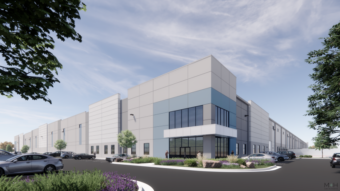While the downtown office market contends with record vacancies and an increasing supply of sublease space for rent, the story appears to be quite a bit different in the growing neighborhood office market. Looking to capitalize on the moment, the property owner of 1735 N. Ashland Avenue, a four-story industrial conversion along the Kennedy Expressway known for its mural wall, has listed the building for sale. The property is being marketed as a package with 1401 W. North Avenue, which also has signage overlooking the expressway.
Perhaps best known by sports fans during the mid-’90s, the building had a large mural featuring Chicago Bulls stars Michael Jordan and Dennis Rodman, as well as Ryne Sandberg of Cubs fame. The Chicago Tribune originally reported about the building being for sale back in March — as well as property owner Ted Wynn’s openness to offers in Bitcoin. This week, brokers are formally rolling out a marketing effort to promote the two-property portfolio.
According to Zach Pruitt, Principal with Cawley Chicago, who is leading the listing effort, the timing is right to sell considering the changes happening along the Chicago River’s north branch and the evolving office market in the city’s neighborhoods.
“The 606 extension will go through the north end of the parking lot of the Ashland Building and there’s also the new Metra station that’s planned,” Pruitt says, referring to two transit improvements that are planned for the Lincoln Yards mega-development closeby. “And then the North Avenue building is near the first life science spec building that Sterling Bay is going to do.”
But then there’s also the investment and development happening at Goose Island, helping lure office tenants from the Fulton Market District or River North to the North Branch. The mural and digital sign buildings certainly benefit from the activity happening in these pockets, says Pruitt.

So how does the mural building function? Is it an ad space or does the property owner decide what goes up along the side of the building? It’s not exactly either one of these, Pruitt explains. Instead, it’s a building identification sign, or essentially signage that serves as corporate branding of the property by existing office tenants.
“If you look around town, there are examples of building identification signs all over,” Pruitt says of the signage. “Just a stone’s throw away, Sterling Bay has a Lincoln Yards building identification sign right there, Morton Salt has their building identification sign on the roof [of the former salt shed], Windy City Fieldhouse [has one].”
Wintrust Bank, which along with The Night Ministry, currently occupies the majority of 1735 N. Ashland has utilized the building’s mural wall. The water tower is currently painted in the likeness of the Chicago flag. Uber currently leases out much of 1401 W. North Avenue, Pruitt indicates.
While both buildings are each roughly three-quarters leased, there’s still some room for value-add, Pruitt suggests. But also by generating income, it makes the proposition much less risky to investors seeking safe, turnkey properties. Both are 30,000 square feet and both flank the interstate, which adds even more predictability to the equation since they’re so similar in a number of ways beyond ownership.
However, investors interested in the package will have to throw out a number first. According to Pruitt, there is no formal price tag on the buildings.
“There’s no set asking price, but from an offering position, they’re positive cash-flowing, value-add investment opportunities,” Pruitt explains. “There’s kind of a ground-zero mentality on what’s to come in the next 10 years of development [in the area] and they’re both exceptional timber loft buildings with a lot of capital investment and improvements given the respective tenants.”




